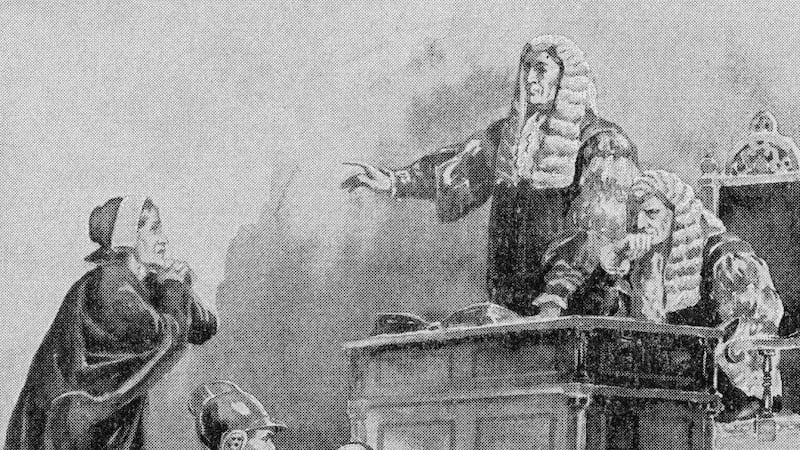In Salem, Massachusetts, in the late 1600s, it was dangerous to have a mole.
It was also dangerous to talk to yourself, to be a pet owner or, especially, to be a woman.
If you had or were any of those things at the time of the Salem Witch Trials, there was a chance you could be accused of being a witch. And a good chance you’d be found guilty and executed.
The fear of witches, warlocks and witchcraft in Salem in 1692 was an ancient one. Hundreds of years before in Europe, people looked to blame sickness, poor crops or diseased livestock on curses and spells.
And as Puritans made a home in the New World, those fears went with them and were personified most often in the weak or least-liked members of a community.
If community leaders were plagued with problems they suspected were caused by the supernatural, they had only to turn to a handy book called the “Malleus Maleficarum,” or “hammer of witches.”
The book had been written in 1486 when the fear of witches lined up with the invention of books that could be circulated, thanks to the printing press.
Written by Heinrich Kramer, an inquisitor of the Catholic Church, along with Jacob Sprenger, the book was the go-to guide for detecting witches. It offered traits and classifications of witches along with ways to determine if a person was a witch and what to do with them if they were found guilty of witchcraft.
In its name, hundreds were tortured and killed, after being found guilty of being a witch.
Many think of ferreting out and killing witches as a thing of the Middle Ages, but the hunt for witches continues today. As late as last September, a Somali man was executed for “witchcraft and sorcery.”
So, what are the signs you have a witch in your presence, according to the book?
Below are 10 helpful hints the Malleus Maleficarum offers to identify witches:
1. Is she a woman?
While men have been persecuted for using witchcraft, the majority of those accused of being witches are women.
Women were believed to be much easier for the devil to tempt.
Midwives were especially thought of as evil and likely witches. According to the book, they murdered and then consumed babies.
2. Does she look like a witch?
Now, be careful here. The book references witches as looking old, “crone-like,” and hobbled.
The Rev. John Gaule in the 1640s insisted that “every old woman with a wrinkled face, a furr’d brow, a hairy lip, a gobber tooth, a squint eye, a squeaking voice, or a scolding tongue is not only suspected, but pronounced for a witch.”
Watch out, grandma.
3. Does a “witch cake” affect her?
This one is a stomach-turner. If you want to know if a person is a witch, you can take the urine of the victim of a witch’s deeds and mix it with rye meal and ash and make a little cake.
Then, you feed it to a dog, or some small creature believed to be one of the witch’s familiars — a small animal or imp that is kept by a witch.
If the person is a witch, the animal will fall into a trance and start naming names, and the witch will be struck with pain as the animal eats the cake and calls her out.
4. How does she stack up against a Bible?
Here is where a good BMI would be helpful. One way used to determine if a person was a witch was to weigh her against a Bible or, maybe a stack of Bibles.
The theory was that if she weighed less than the stack of Bibles, she was guilty. However, in some places, you were witch material if you weighed more than the Bibles.
Of course, some were innocent only if the Bibles matched their exact weight.
5. How does she stack up underwater?
In the ultimate damned if you do, damned if you don’t scenario, suspected witches were often tied to “dunking chairs” and lowered into a river to see if they would sink.
Witches, who would not be baptized due to their contract with the devil, would be spat out by the water, an element used in Christian baptism.
So the theory goes that if a person is dunked in the water and springs out, you’ve got yourself a witch. On the filp side, if a person is dunked in the water and doesn’t come out, she was not a witch. Most often what she was was a drowning victim.
The family at least could be comforted by knowing she was not a witch.
6. Does she talk to herself?
Another sign that a person was potentially a witch was if she was caught talking to herself. One of the women killed during the Salem Witch Trials was Sarah Good, who was sometimes heard talking to herself when she left a person’s home.
When confronted with the “evidence,” Good said she was reciting psalms from the Bible.
She was hanged and her body was believed to have been burned.
7. Does she have a “mark?”
If a woman had a mole or a birthmark, they could be accused of having a pact with the devil. The mole or birthmark was believed to be a sign of such a pact.
If you tried to get around the mole test and remove the mole, the scar was considered proof.
8. Does she not bleed?
If a woman had freckles, they would be pricked with a knife blade or a needle. If a woman did not bleed when pricked, she was a witch.
The catch here was that official “prickers” would often use knives with retractable blades that made it appear a person was stabbed but no blood or mark would be found.
9. Does she have a broomstick? Does she fly around on it?
This seems obvious, but if your neighbor has been seen flying on a broomstick past the elementary school looking for children to bake into a pie, you could have a witch on your hands.
10. Can she say the Lord’s Prayer?
It was believed that witches could not say holy words, so they would be asked to recite the Lord’s Prayer, without mistake, to prove their innocence.
One unfortunate woman misspoke the part of the prayer that says, “lead us not into temptation,” dropping the “not.”
She was quickly hanged for asking God to lead everyone to be tempted to sin.
A man was asked to recite the prayer and did so perfectly but was still put to death because his recitation was considered a “trick.”
©2021 Cox Media Group






